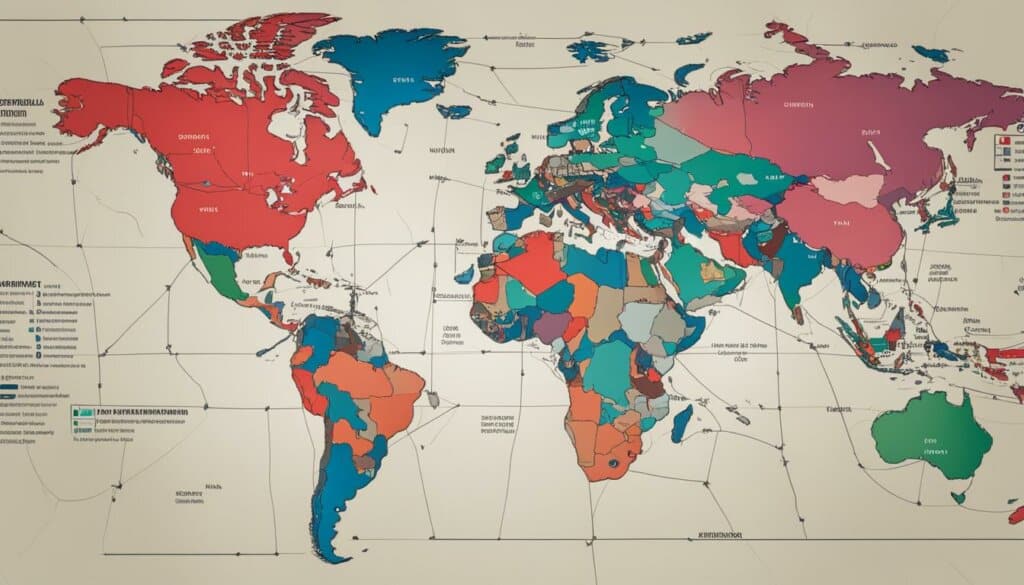Table of Contents
In today’s digital age, the publishing industry is facing increasingly complex cyber threats that put its valuable literary assets at risk. As publishers embrace technology and digitize their operations, it becomes crucial to prioritize cybersecurity and implement robust data protection measures.
Cybersecurity for the publishing industry goes beyond safeguarding sensitive information and extends to protecting intellectual property rights, such as copyrights and trademarks. Adherence to national and international laws and regulations is essential to ensure the integrity and security of literary works.
With the rise of the internet and digital platforms, publishers must be proactive in their approach to secure internet practices. This includes developing a strong data security strategy, encrypting sensitive data, and utilizing specialized software for protection.
The Importance of Intellectual Property Rights in Cyberspace
Intellectual property rights (IPR) play a crucial role in protecting original works in the digital realm. From literature to music, art to inventions, IPR ensures that creators’ efforts are recognized and rewarded. In cyberspace, however, IPR faces numerous challenges, making it more important than ever to safeguard these rights.
Copyright infringement is a significant concern in cyberspace, where unauthorized usage, copying, and distribution of copyrighted works occur. This poses a threat to the rights of creators and the integrity of their work. Additionally, practices like deep linking and framing raise legal questions, as they allow access to copyrighted content without proper authorization.
“The protection of intellectual property rights in cyberspace is essential for fostering creativity and innovation.”
By prioritizing intellectual property rights in cyberspace, we can ensure that creators are rightfully acknowledged and their works are protected from unauthorized use and distribution.
The Challenge of Copyright Infringement
Copyright infringement involves the unauthorized use, distribution, or copying of copyrighted works. In cyberspace, it has become easier than ever to access and share copyrighted content without proper authorization. This poses a significant challenge to copyright owners, as their works are at risk of being exploited or devalued.
The Dilemma of Deep Linking and Framing
Deep linking and framing are practices that allow access to copyrighted content through direct links or embedding. While they can enhance user experience and facilitate information sharing, they also raise legal concerns. The dilemma lies in striking a balance between the rights of copyright owners and the availability of information for users.
| Challenges in Protecting Intellectual Property Rights in Cyberspace | Solutions |
|---|---|
| Copyright infringement | Enhanced enforcement mechanisms, copyright education, and awareness campaigns |
| Deep linking and framing | Clear guidelines and regulations, copyright licensing agreements, and technological solutions |
Protecting intellectual property rights in cyberspace is essential for fostering creativity and innovation. By addressing the challenges of copyright infringement, deep linking, and framing, we can create an environment that respects and rewards the work of creators while promoting the free flow of information.
Laws and Legislations for Intellectual Property Rights in India
India has established a comprehensive legal framework to protect intellectual property rights within its borders. These laws aim to safeguard the rights of creators, inventors, and businesses, ensuring that their intellectual property is safeguarded and that they can reap the benefits of their innovation and creativity.
The Copyright Act, 1957, is one of the central legislations governing intellectual property in India. It provides protection for literary, artistic, musical, and dramatic works, as well as cinematographic films and sound recordings. The act grants exclusive rights to copyright owners, allowing them to reproduce, publish, communicate, and adapt their creations. It also outlines the duration of copyright protection and the penalties for copyright infringement.
In addition to copyright laws, India has enacted legislations to protect other forms of intellectual property. The Patents Act, 1970, governs the grant and protection of patents, granting inventors exclusive rights to their inventions. The Trademarks Act, 1999, focuses on the registration and protection of trademarks, preventing unauthorized use of distinctive signs that identify products or services. The Geographical Indications of Goods (Registration and Protection) Act, 1999, protects goods originating from specific geographical locations, ensuring their unique qualities are recognized and preserved.
| Legislation | Purpose | Year Enacted |
|---|---|---|
| The Copyright Act, 1957 | Protection of literary, artistic, musical, and dramatic works | 1957 |
| The Patents Act, 1970 | Grant and protection of patents | 1970 |
| The Trademarks Act, 1999 | Registration and protection of trademarks | 1999 |
| The Geographical Indications of Goods (Registration and Protection) Act, 1999 | Protection of goods originating from specific geographical locations | 1999 |
These laws, combined with international agreements and treaties, provide a robust legal framework for intellectual property protection in India. They ensure that creators and innovators can enjoy the rights to their intellectual property, promoting innovation, creativity, and economic growth.

The Copyright Act, 1957
“The Copyright Act, 1957, serves as a foundation for intellectual property protection in India. It covers a wide range of works, including literature, music, and film. The act grants exclusive rights to copyright owners, enabling them to control the use and distribution of their creations. Copyright protection encourages creativity and innovation by ensuring that creators can profit from their work.”
Other Laws for Intellectual Property Protection
- The Patents Act, 1970: This act governs the grant and protection of patents, providing inventors with exclusive rights to their inventions and promoting technological advancements.
- The Trademarks Act, 1999: This legislation focuses on the registration and protection of trademarks, preventing unauthorized use of distinctive signs that identify products or services.
- The Geographical Indications of Goods (Registration and Protection) Act, 1999: This act safeguards goods originating from specific geographical locations, protecting their unique qualities and promoting local industries.
Challenges in Protecting Intellectual Property Rights in Cyber Law
The publishing industry faces numerous challenges when it comes to protecting intellectual property rights in the realm of cyber law. One of the major challenges is copyright infringement, which encompasses unauthorized usage, distribution, and copying of copyrighted works. Deep linking and framing also pose significant threats, as they allow access to copyrighted content without proper authorization.
Software piracy is another pressing issue that publishers must address. This involves the unauthorized making and distribution of copies of software. Additionally, cybersquatting, where individuals imitate domain names to deceive users, presents a constant concern. Metatagging is yet another challenge, as it can lead to trademark infringement and dilution of a brand’s identity.
“Copyright infringement, software piracy, and other challenges in protecting intellectual property rights require publishers to take proactive measures and develop comprehensive strategies to safeguard their valuable assets.”
To tackle these challenges, publishers need to foster a proactive approach and develop a comprehensive intellectual property management strategy. This entails implementing robust data security measures, such as encryption, to safeguard their digital assets. It’s also crucial to educate employees about the importance of intellectual property protection and instill a cybersecurity awareness culture within the organization. By addressing these challenges head-on, publishers can mitigate risks and ensure the security of their intellectual property.
The Challenges in Protecting Intellectual Property Rights in Cyber Law
“Copyright infringement, software piracy, and other challenges in protecting intellectual property rights require publishers to take proactive measures and develop comprehensive strategies to safeguard their valuable assets.”
The publishing industry faces numerous challenges when it comes to protecting intellectual property rights in the realm of cyber law. One of the major challenges is copyright infringement, which encompasses unauthorized usage, distribution, and copying of copyrighted works. Deep linking and framing also pose significant threats, as they allow access to copyrighted content without proper authorization.
Software piracy is another pressing issue that publishers must address. This involves the unauthorized making and distribution of copies of software. Additionally, cybersquatting, where individuals imitate domain names to deceive users, presents a constant concern. Metatagging is yet another challenge, as it can lead to trademark infringement and dilution of a brand’s identity.
| Challenges in Protecting Intellectual Property | Solutions and Strategies |
|---|---|
| Copyright infringement | Develop a comprehensive intellectual property management strategy that includes robust data security measures like encryption. Educate employees on the importance of intellectual property protection. |
| Software piracy | Implement strict controls on the distribution and usage of software within the organization. Raise awareness among employees about the consequences of software piracy. |
| Cybersquatting | Monitor and protect domain names associated with the organization. Take legal action against cybersquatters when necessary. |
| Metatagging | Regularly monitor and review the use of metatags to prevent trademark infringement. Implement clear guidelines for the use of metatags by employees. |
Addressing these challenges requires publishers to take proactive measures and develop comprehensive strategies to safeguard their valuable assets. By prioritizing intellectual property protection and staying vigilant against cyber threats, publishers can ensure the integrity and security of their creative works.
Steps to Protect Intellectual Property
In order to protect intellectual property, publishers should implement a comprehensive data security strategy. This involves identifying sensitive data, such as personally identifiable information (PII) and copyrighted content, and implementing protection mechanisms.
Encryption is a crucial aspect of data security. Publishers should ensure that their data, including hard drives, files, and folders, is encrypted both when stored and in transit. This can help prevent unauthorized access and mitigate the risk of data breaches.
Additionally, using specialized software can provide an extra layer of protection. Data Loss Prevention (DLP) solutions, for example, can help prevent unauthorized transfer and storage of sensitive data. By implementing controls on device connectivity and establishing privacy awareness among all staff, publishers can further enhance their data security measures.
Furthermore, it is important to regularly update and patch software to address any vulnerabilities that may be exploited by cyber threats. By prioritizing software security and staying informed about the latest security patches, publishers can strengthen their overall data security posture.
| Steps to Protect Intellectual Property | Summary |
|---|---|
| Develop a robust data security strategy | Identify sensitive data and implement protection mechanisms |
| Encrypt data | Secure data both when stored and in transit |
| Use specialized software | Implement Data Loss Prevention (DLP) solutions |
| Implement controls on device connectivity | Prevent unauthorized transfer and storage of sensitive data |
| Establish privacy awareness among all staff | Enhance overall data security measures |
| Regularly update and patch software | Strengthen overall data security posture |
Prioritizing Intellectual Property and Conducting Risk Analysis
Prioritizing intellectual property is crucial for publishing companies to protect their valuable assets from cyber threats. By identifying the most valuable works and assessing the risks associated with their loss or theft, publishers can make informed decisions on the implementation of security measures.
Conducting a comprehensive risk analysis is essential in determining where to allocate security efforts and resources. This analysis should consider the types of data that need protection, such as personally identifiable information, financial data, contractual information, and copyrighted content. By understanding the value and vulnerabilities of their intellectual property, publishers can effectively prioritize their security measures.

In order to conduct a risk analysis, publishers can follow these steps:
- Identify the intellectual property assets: Determine the works that hold the most value for the company, whether they are bestselling books, well-known brands, or innovative technologies.
- Assess the potential threats: Evaluate the risks that these assets may face, such as cyber attacks, data breaches, copyright infringement, or unauthorized usage.
- Analyze the impact: Understand the potential consequences of a security breach or loss of intellectual property, including financial losses, reputational damage, and legal implications.
- Evaluate the existing security measures: Review the current security protocols and determine their effectiveness in safeguarding intellectual property.
- Implement additional measures: Based on the risk analysis, identify areas where additional security measures are needed, such as encryption, access controls, and employee training programs.
- Regularly review and update the risk analysis: As the publishing industry evolves and new threats emerge, it is essential to regularly update the risk analysis to ensure the ongoing protection of intellectual property.
By prioritizing intellectual property and conducting a thorough risk analysis, publishing companies can take proactive steps to protect their valuable assets from cyber threats and ensure the long-term success of their business.
Labeling and Securing Intellectual Property
Properly labeling intellectual property is an essential step in protecting its confidentiality and ensuring compliance with copyright laws. By clearly marking documents and digital files with labels, publishers can raise awareness among employees and external parties about the sensitive nature of the information. Labels can be displayed on documents, log-in screens, and other relevant platforms to remind individuals of the need for caution and adherence to data protection protocols.
In addition to labeling, securing intellectual property requires a combination of physical and digital security measures. Physical security involves locking rooms and devices that store sensitive data to prevent unauthorized access. Digital security measures, such as implementing strong passwords and access controls, can help safeguard digital assets from cyber threats. Encryption is another crucial aspect of digital security, ensuring that data remains unreadable to unauthorized individuals even if it is intercepted.
“Properly labeling intellectual property is not only important for compliance, but it also serves as a visual reminder for everyone to handle sensitive information with care.”
By effectively employing both physical and digital security measures, publishers can significantly reduce the risk of unauthorized access to intellectual property and minimize the potential for data breaches.

| Physical Security Measures | Digital Security Measures |
|---|---|
| Locking rooms and cabinets storing sensitive data | Implementing strong passwords and access controls |
| Controlling access to physical storage devices | Encrypting data to protect it from unauthorized access |
| Using surveillance systems to monitor physical spaces | Regularly updating software and security patches |
| Implementing visitor access controls and visitor logs | Conducting regular security audits and assessments |
Employee Education and Training on Intellectual Property Protection
Employee education and training play a crucial role in ensuring effective cybersecurity awareness and data protection best practices within the publishing industry. By empowering employees with the knowledge and skills to recognize and mitigate potential cybersecurity threats, publishers can significantly reduce the risk of data breaches and intellectual property theft.
“Training should cover basic cybersecurity principles, best practices for sensitive data protection, and methods to avoid common threats.”
An employee education program should include training on identifying and responding to phishing attacks, using strong and unique passwords, securely handling personal data, and recognizing and reporting suspicious activities. By making employees aware of the potential risks and providing them with practical tools and knowledge, publishers can create a culture of cybersecurity awareness and promote a collective effort to protect valuable intellectual property.
Additionally, regular training sessions and workshops should be conducted to keep employees updated on emerging cybersecurity trends and technologies. This ongoing education ensures that employees are equipped with the latest knowledge and skills necessary to navigate the ever-evolving cybersecurity landscape.
Benefits of Employee Education and Training
The benefits of employee education and training on intellectual property protection extend beyond reducing the risk of data breaches. By fostering a culture of cybersecurity awareness, publishers can also benefit from:
- Increased employee accountability and responsibility in safeguarding sensitive data
- Improved incident response and mitigation capabilities
- Enhanced overall cybersecurity posture
Investing in employee education and training is a proactive approach to protecting intellectual property and ensuring the long-term security and success of publishing companies.
Taking a Holistic Approach to Intellectual Property Protection
Protecting intellectual property requires a holistic approach that encompasses all aspects of the organization. By engaging key stakeholders, such as legal, human resources, IT, and R&D, in the protection efforts, publishers can strengthen their defenses against potential threats. Effective communication and collaboration among these functions are essential for the successful implementation of intellectual property protection strategies.
The Counter-Intelligence Mindset
Adopting a counter-intelligence mindset is crucial in the battle to safeguard intellectual property. By thinking like a potential spy and identifying vulnerabilities within the organization, publishers can proactively address security risks. This involves securing sensitive information through methods such as shredding documents, encrypting files, and monitoring employee activities. By taking a proactive stance, publishers can stay one step ahead of potential threats.
A Global Perspective
While protecting intellectual property, it is crucial to have a global perspective. Different countries have varying levels of intellectual property protection and enforcement, making it essential for publishers to understand and navigate these complexities. By staying informed about international laws and regulations, publishers can ensure that their intellectual property is protected on a global scale.
| Benefits of a Holistic Approach | Actions |
|---|---|
| Enhanced security | Collaborate with key stakeholders to identify and address vulnerabilities |
| Proactive risk management | Adopt a counter-intelligence mindset and implement proactive security measures |
| Global compliance | Stay up-to-date with international laws and regulations |
| Reduced risk of intellectual property theft | Implement comprehensive security measures to protect valuable assets |
By taking a holistic approach, adopting a counter-intelligence mindset, and considering the global perspective, publishers can ensure the protection of their intellectual property. By prioritizing the security of their literary assets, publishers can mitigate risks and safeguard their valuable content from unauthorized access and data breaches.

Conclusion
Cybersecurity is a critical concern for the publishing industry, especially in safeguarding valuable intellectual property. Adhering to intellectual property rights laws and implementing robust data security strategies are essential for protecting publishers’ assets. Encryption, specialized software, and employee awareness training play key roles in safeguarding intellectual property from unauthorized access and data breaches.
By taking a holistic approach and prioritizing intellectual property, publishers can mitigate risks and ensure the security of their literary assets. Ongoing vigilance and proactive measures are necessary in the ever-evolving landscape of cybersecurity. By staying updated on data protection best practices and utilizing the right tools, publishers can safeguard their intellectual property and maintain the trust of their audiences.
Protecting intellectual property is not just a legal obligation, but also a strategic advantage in the digital era. Publishers need to adopt comprehensive data protection measures and foster a culture of cybersecurity awareness to stay ahead of potential threats. By investing in cybersecurity for the publishing industry, publishers can continue to thrive in the digital age while protecting their valuable intellectual property.
FAQ
What are the main cyber threats faced by the publishing industry?
The publishing industry faces threats such as copyright infringement, software piracy, cybersquatting, and data breaches.
How can intellectual property rights be protected in the cyberspace?
Intellectual property rights can be protected by implementing effective intellectual property management strategies and adhering to national and international laws.
What laws and legislations are in place in India to protect intellectual property rights?
India has enacted various laws, including the Patents (Amendment) Act, the Copyright (Amendment) Act, the Trademarks Bill, the Geographical Indications of Goods (Registration and Protection) Bill, and the Industrial Designs Bill.
What are the main challenges in protecting intellectual property rights in cyber law?
The main challenges include copyright infringement, software piracy, deep linking, framing, and cybersquatting.
What steps can publishers take to protect their intellectual property?
Publishers can develop a robust data security strategy, encrypt their data, use specialized software for protection, and prioritize intellectual property.
How can publishers prioritize their intellectual property and conduct a risk analysis?
Publishers can prioritize intellectual property by identifying valuable assets and assessing the risks associated with their loss or theft. Conducting a risk analysis helps determine where to allocate security efforts and resources.
How can intellectual property be labeled and secured?
Intellectual property can be labeled through banners, labels, and notices to raise awareness among employees and external parties. Physical security measures, such as locking rooms and devices, and digital security measures, like passwords and encryption, can be implemented to secure intellectual property.
How can employees be educated and trained on intellectual property protection?
Employees can be educated through training that covers basic cybersecurity principles, best practices for data protection, and methods to avoid common threats. This includes avoiding clicking on suspicious links, keeping systems updated, and using secure channels for transferring sensitive information.
What is the importance of taking a holistic approach to intellectual property protection?
Taking a holistic approach involves engaging key stakeholders, adopting a counter-intelligence mindset, and considering global perspectives on intellectual property protection. This ensures comprehensive protection and reduces vulnerabilities.
Why is cybersecurity important for the publishing industry?
Cybersecurity is important for the publishing industry to protect valuable intellectual property, adhere to intellectual property rights laws, and safeguard literary assets against data breaches and unauthorized access.
Source Links
- https://www.endpointprotector.com/blog/managing-data-security-in-the-publishing-industry/
- https://enhelion.com/blogs/2022/09/01/role-of-intellectual-property-in-cyber-law/
- https://www.csoonline.com/article/544738/intellectual-property-protection-10-tips-to-keep-ip-safe.html













